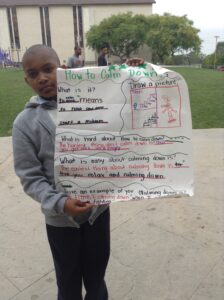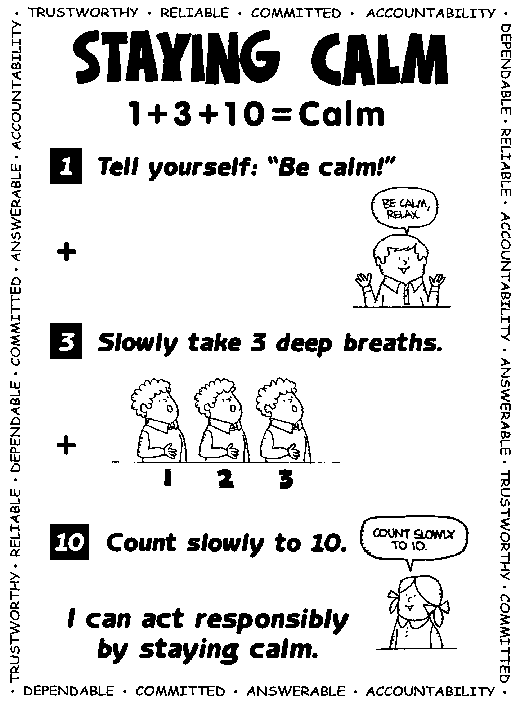How to Help Kids Manage Anger, Calm Down and Self-Regulate
Does your child have difficulty controlling his anger? Does he resort to using aggressive behaviors such as biting, hitting, spitting or fighting? Does he yell or quickly lose control? If so, you’re not alone. Nearly two-thirds of U.S. adolescents have experienced an anger attack that involved threatening violence, destroying property or engaging in violence toward others at some point in their lives. These severe attacks of uncontrollable anger are much more common among adolescents than previously recognized, finds a new study led by researchers from Harvard Medical School.
Signs A Child May Have Anger Issues
Yelling. Fighting. Hitting. Tantrums. Biting. Sound familiar? They are typical behaviors of quick-to-anger children. But don’t forget that anger isn’t always displayed as an outburst—some kids hold their intense feelings inside. Unreleased anger and pent-up frustrations can lead to anxiety and even depression. Over the years I’ve received hundreds questions from parents, and by far the largest number deal with how to help kids handle anger. Your first step to helping your child is to recognize the signs that your child may have anger issues.
Frequent angry outbursts, even over minor issues
Unable to explain feelings when upset
Trouble calming down when frustrated or upset even to the point of hyperventilating
Resorts to using physical aggression such as hitting, fighting, kicking, shouting, spitting, swearing, tantrums
Doesn’t seem to care about animals’ or people’s feelings
Doesn’t accept responsibility for his aggression; blames others
Needs reminders, coaxing or reprimands to control temper
Trouble bouncing back from frustrations
Acts without thinking
Behaves recklessly
Super sullen, silent and holds in feelings
Talks, writes or draws pictures about violence
Bullying or acting aggressively towards others
Of course, any of those issues could mean something else. So watch the behavior closely. Also, track it. Mark the frequency that you see the behavior occurring on a calendar. (You also may want to mark the time and place it occurs. Anger generally is situational: it happens more at certain times, with certain people, or regarding certain issues. If you track the behavior (just like you would for an illness) you may see a pattern that will be immensely helpful in curbing the anger).
Most importantly: if you want your kid to handle anger more appropriately ,then he must learn substitute behaviors to relieve that pent-up energy and replace the current unhealthy strategies.
Some parents swear that learning the deep breathing yoga techniques helped their kids manage their anger while others say their teens relax more when they go to a dark room and listen to quiet music.
The trick is to find what works best for your child so he can learn how to take control of his temper and use the same tip each and every time until it becomes a habit and he can use the strategy without you. That will take practice, practice, practice.
Each child is different so it’s best to use the trial and error approach: teach a strategy and then watch to see how your child responds. If the strategy and your child seem to “click” then focus on that one technique by practicing it again and again until your child can use it alone. That may take some time-after all you are helping your child change a habit-so hang in there.
The photo at the top is of a student who was having trouble calming his anger. (And for legitimate reasons- his parents were going through a horrific divorce and their anger with each other was spilling over to their children. I was visiting the school and the boy came running up to me with his “Calm Down” poster. So proud! And so elated! His teacher was showing him ways to calm down. He was getting back in control on himself because he’d learned a “replacer” skill” a healthy strategy to use in place of the anger. That’s what we often fail to do: teach kids what to do instead of their angry outbursts.
You should see a gradual diminishment of the anger as your child gains self-control and applies the “anger replacer” skill. Track how often your child is practicing the technique. If you do not see a change in behavior after a few weeks or if the child’s anger intensifies, becomes more frequent, lasts longer, or becomes a safety issue for your child or others seek the help of a trained professional.
Ways to Help Kids Handle Hot Feelings in Healthier Ways
1. Develop a feeling vocabulary
Many kids display aggression such as kicking, screaming, hitting, biting because they simply don’t know how to express their frustrations any other way. They need an emotional vocabulary to express how they feel, and you can help your kid develop one. Here are a few words to start with: angry, upset, mad, frustrated, agitated, furious, apprehensive, tense, nervous, anxious, irritated, furious, ticked off, irate. Once your child learns emotion words, encourage him to “talk out his anger.”
Beware: Your child might yell, “I’m really angry!” Or blurt out: “You make me so mad.” Do not discipline him. It’s exactly what you want him to do so he learns to express his anger instead of lashing out or holding the anger in.
2. Use self-talk
Teach a simple, positive message your child can say to himself in stressful situations. For example: “Stop and calm down,” “Stay in control,” “I can handle this.”
3. Pound it out
Pound clay, hit a pillow, shoot baskets, punch a punching bag, throw rocks at a wall (away from people), hit a wall with a foam bat. Help your child find the most effective way to calm his temper, and then encourage him to use the technique. Caution: most research finds that this strategy can backfire and increase the impulsivity. Use it only if you see a decrease in your child’s anger.
4. Go to a calm spot
Ask your child to help you set up a place where he can go to gain control. Offer a few soothing things-such as books, music, pens, and paper-to your child and then encourage him to use the spot to cool down.
5. Tear your anger into little pieces
Tell your child to draw or write what is upsetting him on a piece of paper. Then tear it into little pieces and “throw the anger away.” He can also use the concept by imaging that his anger is slowly leaving him in little pieces. Make sure you provide scratch paper!
6. Teach: “Stop and breathe”
Show your child how to inhale slowly to a count of five, pause for two counts, and then slowly breathe out the same way, again counting to five. Repeating the sequence creates maximum relaxation and reduces stress that can turn into anger.
7. Teach “1 + 3 + 10”
Explain the formula: “As soon as you feel your body sending you a warning sign that says you’re losing control, do three things. First, stop and say: ‘Be calm.’ That’s 1. Now take three deep, slow breaths from your tummy. That’s 3. Finally, count slowly to ten inside your head. That’s 10. Put them all together and you have 1 + 3 + 10, and doing it helps you calm down and get back in control.” (Teach a younger child use DRAGON BREATHS. Blow your anger out just like a dragon!)
8. Imagine a calm place
For instance: the beach, his bed, grandpa’s backyard, a tree house. The second your child feels his body warning signs kick in, tell him to close his eyes and imagine the spot, while breathing slowly. Taking a photograph of the actual “calm place” or drawing a picture of it and then framing it and putting it by your child’s bed can be a great visual reminder.
9. Draw it!
Some kids find drawing to be relaxing. If this is your child stock a basket with markers, crayons and a sketch pad and encourage him to go “draw out his anger.” You can also keep a spare drawing pad in the bottom of his backpack.
10. Write it!
Other kids find that writing out their anger can be effective. If this is your child then provide a journal and a pen or a paper and pencil and encourage her to go to a calm spot and “write away her anger.” Some kids prefer to write a letter to the person they are irritated with – though caution the child about actually presenting the letter to the person. Best to write it when you’re upset, and then rip it up.
Calming a hot-temper is not only teachable, but also essential for growing up in a sometimes violent, unpredictable world. Besides, eliminating this behavior will do absolute wonders in creating not only a child who is far more enjoyable to be with, but also a more peaceful family. If you’re consistent you’ll be able to help your kid learn a healthier way to handle his anger. So don’t wait and don’t give up! (And one more thing…make sure you are calm when you teach your child the tip!)
Best!
Michele
Dr. Michele Borba, Parenting Expert
 I am an educational psychologist, parenting expert, and author of 22 books. My latest is called, THRIVERS: The Surprising Reasons Why Some Kids Struggle and Others Shine. It’s filled with science-backed ways to raise more resilient children so they thrive both now and later. Chapter four is filled with ways to nurture self-control in our children.
I am an educational psychologist, parenting expert, and author of 22 books. My latest is called, THRIVERS: The Surprising Reasons Why Some Kids Struggle and Others Shine. It’s filled with science-backed ways to raise more resilient children so they thrive both now and later. Chapter four is filled with ways to nurture self-control in our children.
You can also refer to my blog, Dr. Borba’s Reality Check for ongoing parenting solutions and late-breaking news and research about child development.
My book UNSELFIE: Why Empathetic Kids Succeed in Our All-About-Me World is filled with common-sense solutions based on the latest science to help us raise compassionate, caring, courageous kids. It’s time to include “empathy” in our parenting and teaching!
For more parenting advice, follow me on twitter @MicheleBorba, go to my website, MicheleBorba or subscribe to my blog, Dr. Borba’s Reality Check.



